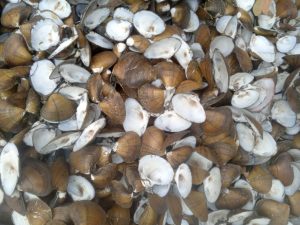The Health Benefits and Nutritional Properties of Oysters

Oysters are a nutrient-dense seafood offering numerous health benefits. Rich in vitamins, minerals, and omega-3 fatty acids, they support heart health, boost the immune system, enhance brain function, and promote strong bones. Discover how incorporating oysters into your diet can improve overall well-being and vitality.
The Health Benefits of Oysters
Oysters are not only a delicacy but also packed with numerous health benefits.
- Rich in Nutrients: Oysters are an excellent source of vitamins and minerals, including vitamin B12, zinc, selenium, iron, and copper.
- High in Protein: They provide high-quality protein, which is essential for muscle repair and growth.
- Omega-3 Fatty Acids: Oysters are a good source of omega-3 fatty acids, which support heart health and reduce inflammation.
- Boosts Brain Health: The high levels of vitamin B12 in oysters help maintain brain health and prevent cognitive decline.
- Supports Bone Health: Oysters contain vitamin D, copper, zinc, and manganese, which are crucial for bone strength and preventing osteoporosis.
- Enhances Immune Function: The zinc content in oysters boosts the immune system and helps fight off infections.
- Promotes Heart Health: Omega-3 fatty acids and other nutrients in oysters help lower the risk of heart disease.
- Improves Vision: Oysters are rich in vitamin A, which is essential for good vision.
- Aids in Weight Loss: Oysters are low in calories and high in nutrients, so they can be a great addition to a weight loss diet.
- Boosts Energy Levels: The iron content in oysters helps prevent anaemia and boosts energy levels.
Including oysters in your diet can provide these health benefits, but it’s important to consume them in moderation and ensure they are properly cooked to avoid any potential health risks.
Chemical Properties of Oysters

- Protein Content: Oysters are rich in high-quality proteins, which are essential for muscle repair and growth.
- Minerals: They contain significant amounts of calcium, magnesium, sodium, copper, iron, nickel, and strontium.
- Vitamins: Oysters are a good source of vitamins, including vitamin B12, vitamin D, and vitamin A.
- Fatty Acids: They are rich in omega-3 fatty acids, which support heart health and reduce inflammation.
- Glycogen: Oysters have high glycogen content, which provides energy and contributes to their sweet taste.
- Antioxidants: They contain antioxidants that help protect cells from damage caused by free radicals1.
- Low in Fat: Oysters are low in fat and cholesterol, making them a healthy dietary choice.
- Polysaccharides: These complex carbohydrates in oysters have various health benefits, including immune support.
- Taurine: This amino acid in oysters supports cardiovascular health and helps regulate blood pressure.
- Calcium Carbonate: The shells of oysters are predominantly composed of calcium carbonate, which is used in various industries.
These chemical properties make oysters a valuable addition to a balanced diet, providing numerous health benefits.
How to Use Oysters as Food for Medicinal Value
Oysters can be used in various ways to harness their medicinal value. Here are some methods:
- Raw Oysters: Consuming raw oysters on the half shell is a popular way to enjoy their full nutritional benefits, including high levels of zinc, vitamin B12, and omega-3 fatty acids.
- Oyster Stew: Cooking oysters in a stew with vegetables and herbs can make a nutritious and comforting meal that supports immune function and bone health.
- Grilled Oysters: Grilling oysters with a bit of garlic and lemon juice enhances their flavour while retaining their nutritional value.
- Oyster Soup: A warm oyster soup can be soothing and is packed with essential nutrients like iron and selenium, which support overall health.
- Oyster Supplements: For those who do not enjoy the taste of oysters, desiccated oyster supplements are available. These provide the same nutrients in a convenient form.
- Oyster Tacos: Incorporating oysters into tacos with fresh vegetables and a light dressing can make a delicious and nutritious meal.
- Oyster Pasta: Adding oysters to pasta dishes can boost the nutritional content, providing a good source of protein and essential minerals.
- Oyster Casserole: Baking oysters in a casserole with other healthy ingredients can be a hearty and nutritious option.
- Oyster Salad: Mixing oysters into a salad with leafy greens, nuts, and a light vinaigrette can make a refreshing and nutrient-dense meal.
- Oyster Chowder: A creamy oyster chowder can be both delicious and beneficial for health, providing a rich source of vitamins and minerals
How to Farm Oysters
Farming oysters, also known as oyster aquaculture, involves several steps to ensure a successful harvest. Here’s a basic guide to get you started:
1. Selecting the Right Location
- Water Quality: Choose a location with clean, brackish water where fresh and saltwater mix. Avoid areas near pollution sources like industrial sites or sewage treatment plants.
- Tidal Range: Look for areas with a high tidal range to help flush out the water and keep your oysters healthy.
2. Setting Up Your Farm
- Equipment: Purchase or build necessary equipment such as cages, bags, or trays to hold your oysters.
- Transportation: Ensure you have a boat or other means to access your farm.
- Maintenance Tools: Have tools ready for maintaining and repairing your equipment.
3. Growing Your Oysters
- Spat Collection: Start with oyster spat (juvenile oysters) from a hatchery.
- Feeding: Oysters are filter feeders and rely on the surrounding water for food.
- Ensure a steady supply of plankton by regularly changing the water in their cages or trays.
- Monitoring: Keep an eye on water conditions such as temperature, salinity, and cleanliness to ensure healthy growth.
4. Harvesting Your Oysters
- Timing: It can take 12-36 months for oysters to reach maturity, depending on the species and growing conditions.
- Methods: Harvest manually or use mechanical equipment like a dredge.
- Cleaning and Sorting: After harvesting, clean and sort your oysters before selling them to restaurants or seafood markets.
5. Farming Methods
- Bottom Culture: Oysters are grown on the seabed, which is a traditional method.
- Off-Bottom Culture: Oysters are grown in cages or bags suspended above the seabed to protect them from predators and improve growth rates.
- Longline Culture: Oysters are attached to long ropes suspended in the water, allowing for better water flow and nutrient access.
6. Environmental Benefits
- Water Filtration: Oysters filter and clean the water, improving the overall health of the marine ecosystem.
- Habitat Creation: Oyster farms provide habitats for various marine species.
7. Regulations and Permits
- Local Laws: Check with local authorities for regulations and permits required for oyster farming.
- Workshops: Many coastal agricultural extension offices offer workshops and technical support for new oyster farmers
Safety and Side Effects of Oysters
some safety considerations and potential side effects to be aware of:
Safety Considerations
- Bacterial Contamination: Raw oysters can carry harmful bacteria like Vibrio vulnificus, which can cause severe illness or even death. It’s recommended to cook oysters to an internal temperature of 145°F to kill harmful bacteria.
- Viral Contamination: Oysters can also harbour viruses such as Norwalk-type viruses and enteroviruses. These can cause gastrointestinal issues and other health problems.
- Heavy Metals: Oysters can accumulate heavy metals like lead, cadmium, and mercury from their environment. Consuming contaminated oysters can lead to heavy metal poisoning.
- Allergic Reactions: Some people may have allergic reactions to shellfish, including oysters. Symptoms can range from mild (hives, itching) to severe (anaphylaxis).
Potential Side Effects
- Food Poisoning: Symptoms of food poisoning from contaminated oysters include nausea, vomiting, diarrhoea, abdominal pain, fever, and chills.
- Respiratory Issues: Inhaling oyster dust or fumes during preparation can cause respiratory problems.
- Gastrointestinal Distress: Eating raw or undercooked oysters can lead to gastrointestinal distress due to bacterial or viral contamination.
- Neurological Symptoms: In rare cases, severe contamination can lead to neurological symptoms such as headaches, dizziness, and confusion.
Prevention Tips
- Cook Thoroughly: Always cook oysters to an internal temperature of 145°F to kill harmful bacteria and viruses.
- Source Carefully: Purchase oysters from reputable sources that follow proper safety guidelines.
- Avoid Raw Consumption: If you have a weakened immune system, are pregnant, or have underlying health conditions, avoid eating raw oysters.
- Check for Recalls: Stay informed about any oyster recalls or warnings from health authorities
External links
How to Farm Oysters
Safety and Side Effects of Oysters







Review Oysters (Health Benefits).
You must be logged in to post a review.